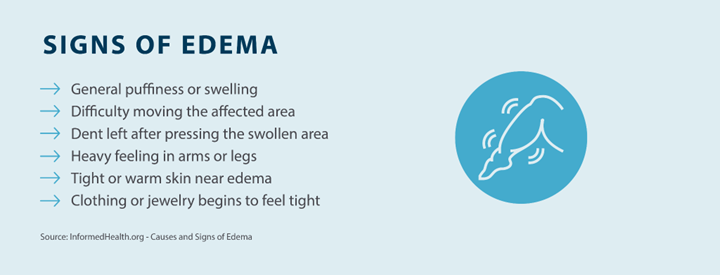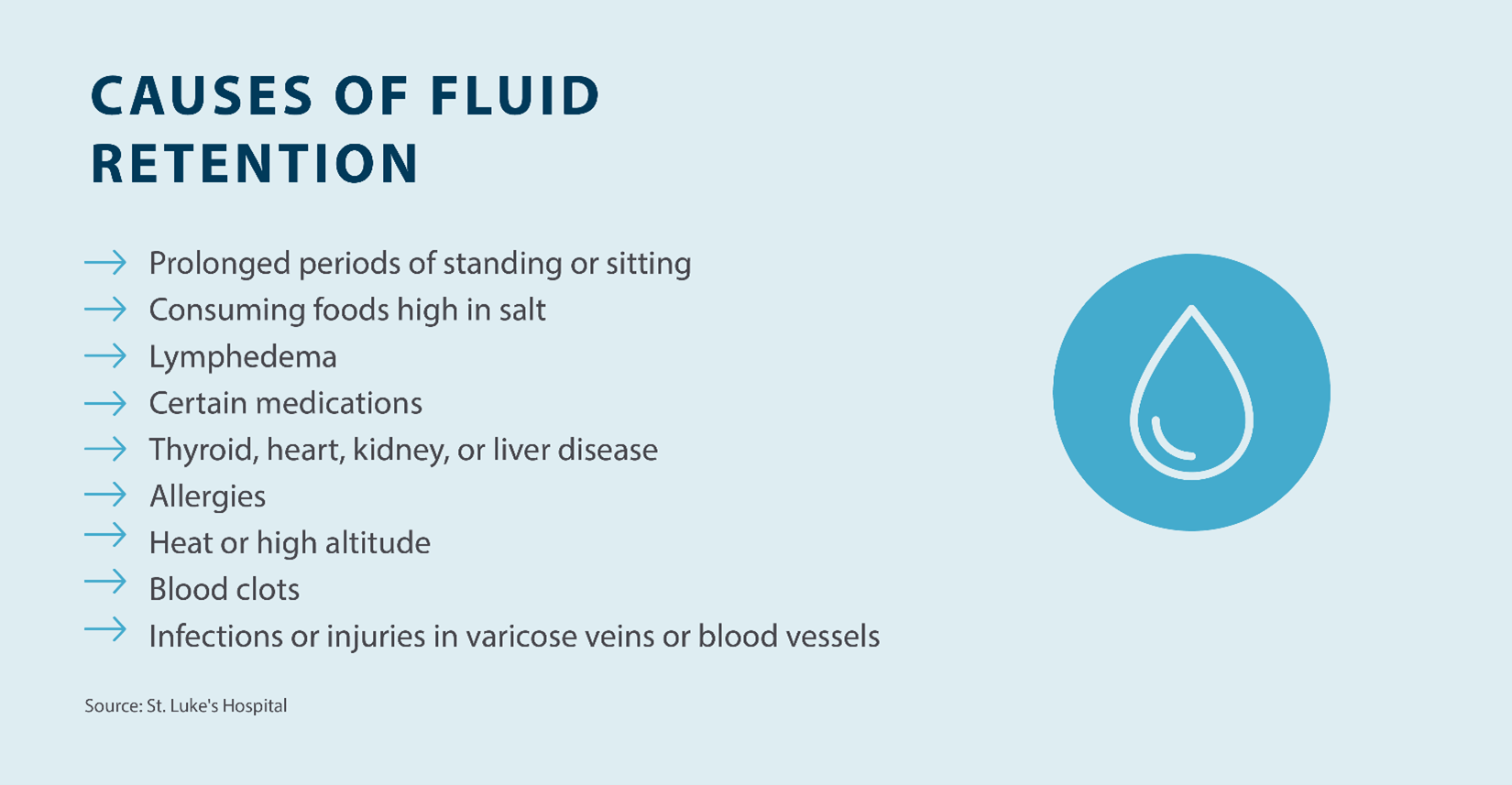Peripheral Edema
Review our guide on peripheral edema to learn about its symptoms, causes, and treatment, so you can manage your condition.
Read More

If you’re living with edema, finding ways to reduce and manage the symptoms of edema is one of the most important things that you can do. Dietary changes can be an effective tool for managing edema symptoms. Reducing your sodium intake is the primary focus reduce the effects of edema. A protein and fiber-rich diet may also help improve edema symptoms for some people. If you want to learn more about the ideal diet to control edema, read on.
What Is Edema?
What Are the Signs of Edema?
What Are the Causes of Water Retention in the Legs?
What Foods Help Reduce Edema?
Additional Edema Treatment Options
Wrapping Up: Best Foods for Edema
Edema is swelling that occurs when there is a buildup of fluid in the tissues of your body. This fluid retention can be caused by several factors, such as a blood clot, allergic reaction, or a chronic condition like lymphedema, which is the swelling in a leg, arm, head, neck, or other areas of the body. While edema can affect various body parts, most people notice the symptoms in their hands, arms, feet, ankles, and legs.
Diagnosing edema is the first step to getting the treatment you need. However, it’s important to note that edema symptoms may present stronger in different parts of the body for different people. Here are some of the signs of edema according to the Institute for Quality and Efficiency in Health Care:

If you’re experiencing several of these signs, you should discuss this with your doctor and get a diagnosis. The earlier you determine the root cause of your symptoms, the earlier you can make the necessary lifestyle changes to get better.
Edema is caused by a buildup of fluid in your body, but what exactly causes that buildup? There are a handful of medications and medical conditions, dietary choices, and general habits that can lead to increased fluid retention, or edema.

In some cases, edema may be caused by sitting or standing for long periods. When you aren’t moving around regularly, fluid can pool in your legs, leading to edema. Edema can also be caused by hot weather because the body tends to retain more fluid when it’s hot.
Certain medications can cause increased water retention that leads to edema, including high blood pressure medications, non-steroidal anti-inflammatory drugs (NSAIDs), and corticosteroids. Following your doctor’s instructions when taking these medications is critical.
Your diet can also contribute to increased fluid retention. Edema can occur if you’re not getting enough protein or vitamin B1. Additionally, your body can retain excess fluid due to a high-sodium diet, which can lead to mild edema in some cases.
Chronic venous insufficiency is a fairly common cause of edema, especially in the legs, feet, and ankles. If your edema is caused by chronic venous insufficiency or another medical condition, you may want to ask your doctor about your treatment options.
Edema may be caused by pregnancy and the hormonal changes that come along with it. While an edema treatment diet may help alleviate the symptoms of edema in these cases, edema may persist to some degree throughout pregnancy.
Because birth control medication contains hormones, it can lead to edema in the same manner that pregnancy can. If you’re considering starting a birth control medication, you should talk to your doctor about the potential risks and side effects first.
Lymphedema is caused by blocked lymph channels, which can happen for a variety of reasons, such as cancer, surgery, or radiation treatment. If you’re suffering from lymphedema, there are several lymphedema treatment and management options that your doctor can recommend to relieve symptoms and pain.
If you’re living with edema, changing your diet is one of the ways to get relief from edema symptoms. The best foods for edema may vary depending on your diet, but there are certain nutrients you should try to get more of and others you should avoid. If you’re considering an edema treatment diet, here’s what you need to know.
The first thing you should do is take a look at your current diet. While eating foods to reduce edema can help, it’s more about correcting dietary problems that could be contributing to edema. Do you consume foods high in sodium? Are you getting enough protein and vitamin B? How much water are you drinking? These are all questions you need to answer before you can decide on a proper edema reducing diet.
First, let’s take a look at some of the foods that are part of an edema treatment diet:
If you’re getting too much sodium in your diet, that could be a contributing factor to edema. Sodium helps your body retain the fluids it needs to function, but an excess of sodium can lead to excessive fluid retention that can cause edema. If you’re already living with edema, your sodium intake may be making your condition worse. Try cutting back on sodium by preparing your own food at home instead of buying processed food. There are even low-sodium seasoning blends you can use to make sure your food has enough flavor without compromising your diet.
Eating foods that are high in protein and vitamin B can also be helpful in treating edema. Your doctor may also recommend cutting out foods that you may be allergic to, including dairy, wheat, soy, and corn. These changes may produce different results depending on your current diet and what you’re allergic to.

It’s important to keep in mind that there’s no one-size-fits-all diet when it comes to treating edema. If you want to make dietary changes to reduce edema symptoms, the first thing you should do is talk to your doctor about your current diet. Your doctor may even use bloodwork and other tests to see which nutrients you’re not getting enough of. You should talk to your doctor before you make any dietary changes to treat edema, as certain dietary changes may have negative effects. Together, you and your doctor can decide on dietary and lifestyle changes that can help reduce your symptoms to make it easier to live with and manage edema.
In addition to making changes to your diet, there are other edema treatment options that can help you manage your symptoms. You can find relief from edema symptoms by making lifestyle changes, wearing compression garments, and more.
As far as lifestyle changes go, losing weight and exercising are other options that can help you manage edema. Lack of exercise can result in fluid pooling in your body, which can lead to edema. By making sure you’re exercising regularly, you can reduce edema symptoms and make it easier to live with.
Compression garments are another solution for edema. These garments work by applying pressure to your arms, legs, or other areas affected by edema, which helps direct the flow of fluid in the affected area to reduce swelling, pain, and other symptoms.
Tactile Medical offers doctor-recommended treatment options, including systems for upper body treatment, head and neck treatment, and lower body treatment. The Flexitouch Plus system is clinically proven to help stimulate your lymphatic system to reduce swelling and relieve edema symptoms. As an effective at-home treatment, you can relieve pain, reduce swelling, and start enjoying life again.
Living with edema can be challenging, especially if your symptoms are severe. The good news is that you can get relief from the symptoms of edema with an edema treatment diet, lifestyle changes, and compression garments. Through exercise and eating a healthy diet, you can make living with edema significantly easier.
If you’re living with lymphedema, Tactile Medical can help. The Tactile Medical Flexitouch Plus system is designed to help stimulate your lymphatic system to relieve lymphedema symptoms, so you can live a happy, healthy life. To learn more about Flexitouch Plus and treating edema, contact Tactile Medical today.
Review our guide on peripheral edema to learn about its symptoms, causes, and treatment, so you can manage your condition.
Read More
Read More
Edema can affect any part of the body, but in some cases, it may only present itself in one leg. Edema in one leg is typically caused by a localized injury or lymphatic malformation that leads to swelling. Swelling in one leg can cause discomfort and affect your daily life,...
Read More
Edema can lead to several symptoms, including edema bruising. People with edema typically bruise more easily, and those bruises may be accompanied by pain. Understanding the symptoms of edema and how to manage chronic swelling can help you control your symptoms and prevent complications.
Read More
Call us at 1.800.575.1900